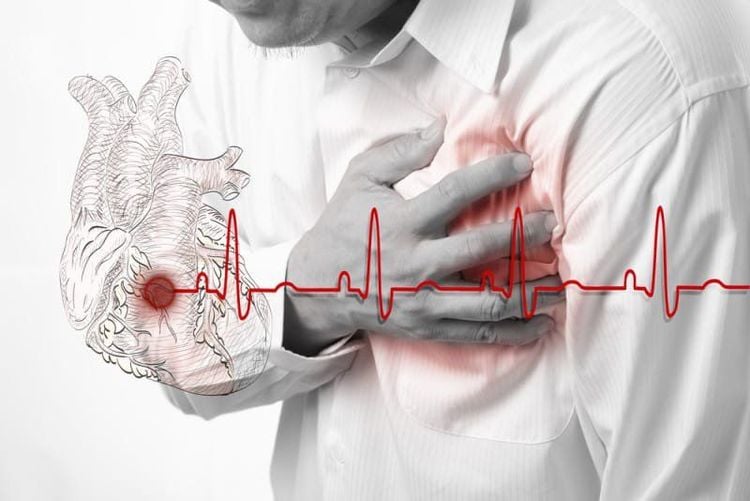This is an automatically translated article.
The article was professionally consulted by Doctor Phan Dinh Thuy Tien - General Internal Medicine - Department of Examination & Internal Medicine - Vinmec Nha Trang International General HospitalBronchiectasis is a condition in the lungs that leads to secondary right heart failure, the incidence is increased in countries with a lot of smokers, polluted environment because this is a risk for chronic disease in lung. If chronic heart disease is properly monitored and treated, the prognosis is good, the disease progression is slower.
1. What is chronic heart disease?
Bronchiectasis is right-sided heart failure secondary to pulmonary arterial hypertension caused by vascular or parenchymal pulmonary disease. Chronic bronchial disease does not include right ventricular failure secondary to left ventricular failure (left ventricular failure due to hypertension, mitral stenosis, aortic stenosis...); congenital heart disease or acquired heart valve abnormalities.Mechanism of disease formation: when a patient has pulmonary hypertension due to vascular or parenchymal causes, it will lead to increased burden on the right ventricle, the right ventricle needs to increase the force of contraction to Pushing blood into the pulmonary artery because it requires a pressure greater than the pulmonary artery pressure, leading to right ventricular dilatation. After a period of time, the right ventricular muscle relaxes in response to the frequent increase in pulmonary pressure to supply enough blood demand for the lungs, leading to right heart failure.

Tăng áp lực động mạch phổi khiến cho thất phải bị giãn gây ra tâm phế mạn
Causes of cardiopulmonary disease Chronic obstructive pulmonary disease (COPD) is a major cause of chronic heart disease. Primary pulmonary hypertension. Asthma that is not under stable control. Surgery or trauma causes a large loss of lung parenchyma. Pulmonary disease. Abnormal anatomy of the thorax or thoracic vertebrae such as kyphosis, scoliosis. Suffering from sleep apnea. Pulmonary fibrosis, pulmonary fibrosis, chronic bronchitis, interstitial pneumonia.
2. Symptoms of chronic heart disease
Clinical symptoms of the disease vary depending on the stage and progression of the disease.Clinical symptoms include:
-Patients have a history of chronic lung diseases, thoracic musculoskeletal diseases.
-Appearance of symptoms of right heart failure include:
Shortness of breath during exertion, later shortness of breath even at light work or at rest. Tired, fast breathing. Tachycardia, in some cases seen or examined the apex of the heart beating below the sternum. Cough: Often coughs a lot, can cough up blood, yellow sputum...

Tâm phế mạn làm xuất hiện những triệu chứng của suy tim phải
- Electrocardiogram (ECG): On the electrocardiogram, the teacher shows signs of right ventricular thickening.
- Cardiopulmonary X-ray: See the following signs:
Signs of pulmonary artery dilatation: The pulmonary artery is raised, the right pulmonary artery branch is dilated over 16mm. Big heart ball or teardrop-shaped heart. It is possible to see lung parenchymal lesions such as pulmonary fibrosis, alveolar dilation... Can be seen if there is an abnormal state of thoracic anatomy, kyphosis scoliosis. - Echocardiography:
2D ultrasound: Show signs of chronic right ventricular overload such as right ventricular wall thickening, abnormal movement of the interventricular septum. On Doppler ultrasound: Calculate pulmonary artery pressure, pulmonary vascular resistance through the spectrum of tricuspid and pulmonary valve regurgitation. Doppler ultrasound is also effective in monitoring and evaluating after treatment. -Respiratory function test:
Pulmonary function test: Often used in COPD. Seeing signs of decreased expiratory volume in the first second, the Tiffeneau index decreased, increasing the patient's lung residual capacity. Some patients with limited ventilation experience a significant reduction in vital capacity. When arterial blood: The first stage is usually nothing special, the later stage has chronic respiratory failure with metabolic acidosis, PaCO2 increased, PaO2 decreased. - Complete blood count: See if there is polycythemia vera, which can be a result of disease and can also be a cause of pulmonary hypertension.
From the medical history, clinical signs and subclinical signs give a definitive diagnosis of:
Stage of disease: From the stage of giving treatment, prognosis and monitoring the patient. Diagnosing the cause of the disease: Finding the cause from which to propose methods to treat the cause of the disease. A diagnosis of cardiac disease must be excluded.

Đa hồng cầu cũng có thể gây tăng áp lực động mạch phổi
3. How to prevent chronic heart disease?
Avoid risk factors for chronic lung disease: Do not smoke, pipe tobacco, avoid exposure to smoke, dust, polluted environment often. When exposed to a toxic environment, it is necessary to use a mask to prevent the risk of affecting the lungs. Vaccinate to prevent respiratory infections such as influenza, pneumococcal... When there are respiratory infections, it is necessary to treat them thoroughly to avoid recurrence. When suffering from chronic diseases, it is necessary to have regular check-ups to detect the disease early. Diet and scientific activities, exercise regularly, practice breathing, have a nutritious diet. When there are chronic lung diseases, it is advisable to have regular check-ups, adhere to treatment and avoid pathogens to limit the development of the disease. The disease develops slowly, causing right heart failure, when heart failure is present, the treatment and prognosis will be more difficult.To protect heart health in general and detect early signs of myocardial infarction and stroke, customers can sign up for Cardiovascular Screening Package - Basic Cardiovascular Examination of Vinmec International General Hospital . The examination package helps to detect cardiovascular problems at the earliest through tests and modern imaging methods. The package is for all ages, genders and is especially essential for people with risk factors for cardiovascular disease.
Please dial HOTLINE for more information or register for an appointment HERE. Download MyVinmec app to make appointments faster and to manage your bookings easily.













